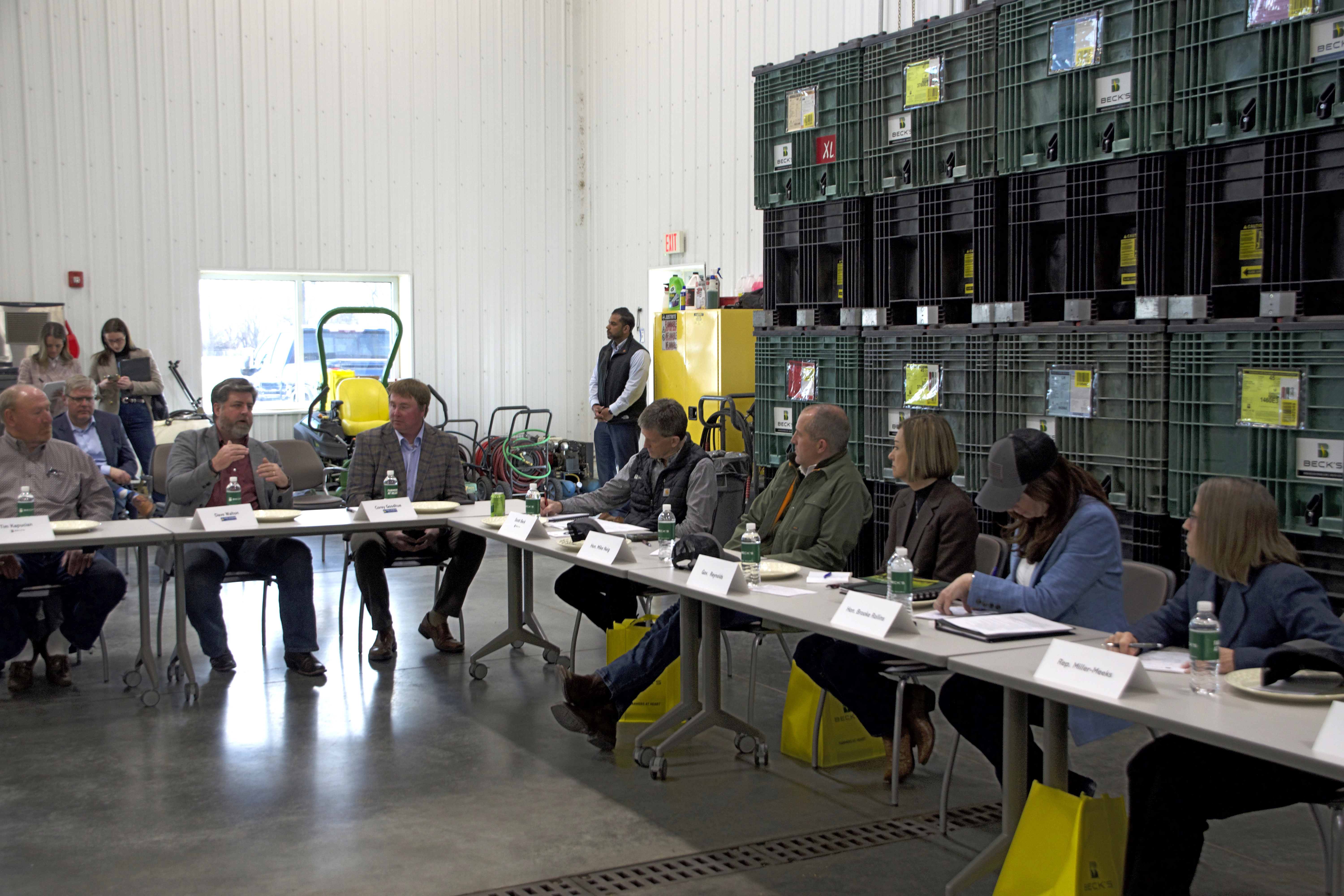
ISA District 6 Director Dave Walton greets U.S. Ag Secretary Brooke Rollins at Beck’s in Colfax. (Iowa Soybean Association/Bethany Baratta)
Farmers reiterate challenges in meeting with ag’s top official
April 8, 2025 | Bethany Baratta
*Editor’s note: Media were allowed into the meeting space to take photos prior to the conversation between Rollins and farmers.
Farm bill, biofuels and tariffs were top of mind as Iowa soybean farmers met with U.S. Secretary of Agriculture Brooke Rollins recently in Colfax. Flanked by Rep. Mariannette Miller-Meeks, Iowa Gov. Kim Reynolds and Iowa Ag Secretary Mike Naig, Rollins listened as 11 Iowa farmers spoke on the issues directly impacting them on the farm. Behind her, stacks of Beck’s Hybrids’ seed ready for field delivery for the upcoming planting season. In an adjacent shop, the media waited for a press gaggle with the Secretary of Ag regarding her first visit to Iowa. Around Rollins, farmers with a flurry of concerns about not only this crop year, but the generations ahead who could be affected by decisions made now.
Iowa Soybean Association (ISA) District 6 Director Matt Willimack said he stressed the urgency of “better practices in trade, farming and the opportunity to bring prosperity to the state of Iowa” during the 30-minute meeting.
A comprehensive farm bill that addresses the needs of soybean farmers—protecting crop insurance, updating reference prices, and expanding trade opportunities for the long-term competitiveness of soybean farmers—was also front and center in the conversation, he said.
“It’s important to me because my son is going to join the farm someday as the seventh generation, and I want him to be as successful as I’ve been,” Willimack said after the closed-door conversation. He grows soybeans and corn and raises cattle near Oxford Junction.
Biofuels
Iowa Soybean Association District 6 Director Dave Walton said he reiterated the opportunity of increasing Renewable Volume Obligations (RVO) for biomass-based diesel to 5.25 billion gallons from 3.35 billion gallons in 2025.
EPA setting these volumes for 2026 and beyond based on the industry’s investments and projections would provide some assurance to biofuel producers and farmers, said Walton, who also serves as secretary on the American Soybean Association (ASA) board of directors.
“This would send a signal to the market that we’re committed to energy independence and domestic energy production,” Walton told me at the conclusion of the event. “This provides a critical market for our soybean oil. And during times like this of depressed prices and a sluggish farm economy, it would give us a good market for soybean oil, which increases the price of soybeans.”
Could this change really make an impact?
“Yes,” Walton said. “It sends an immediate signal to the market that those biodiesel plants that are shut down right now that it’s time to start back up. It would put workers back to work and those plants back to buying soybean oil. It sends an immediate signal to the crush industry that expansions that have put on hold or new plant construction that’s been stopped -that they can get back to work.”
“It's critical we get this done as quickly as possible because it trickles back to the farm gate in the prices we receive for our soybeans. It has a huge impact in local communities where biodiesel and crush plants will be located.”
 Walton, a farmer near Wilton, says eliminating an Indirect Land Use Change (ILUC) penalty, which puts soybean oil-based biodiesel at a disadvantage, would also help.
Walton, a farmer near Wilton, says eliminating an Indirect Land Use Change (ILUC) penalty, which puts soybean oil-based biodiesel at a disadvantage, would also help.
“ILUC is a barrier for getting soybean oil-based biodiesel to certain markets, specifically California and but also federal tax policy like 45Z,” Walton said.
It’s a concept that says if domestic biodiesel volumes grow, creating demand for soybean oil, then a producer in another part of the world is going to have to add another acre to backfill that lost supply of oil. These models assume that this new supply of oil may come from deforestation in far flung places like Brazil or Indonesia (palm oil) which could be a substitute for U.S. soybean oil. Sources which are far less sustainable than U.S. soybean oil.
Because of this, soybean oil-based biodiesel is assigned an artificially high carbon intensity score, he said.
“In practice, it penalizes American farmers for something that’s happening somewhere else in the world,” he said. “It’s clear that we’re farming fewer acres in North America than we were in 2005 when the RFS was first signed ... so really, they’re penalizing us for an issue that’s not even there.”
Eliminating the ILUC score would mean that soybean oil-based biodiesel is competitive with other feedstocks like used cooking oil, distillers corn oil, beef tallow – and with the implementation of climate smart agriculture soybean oil could have an even lower carbon intensity than so-called ‘waste oils’ like animal fats
“All we’re asking for is to level the playing field and make it fair for American row-crop producers,” Walton said.
Sailing ships
Randy Miller, who serves on the ASA board and represents ASA on the U.S. Soybean Export Council (USSEC), thought about U.S. growers’ competitive advantage, he told me after the farmer-only meeting with Rollins. He specifically referenced the U.S. Trade Representative’s (USTR) proposed actions resulting from an investigation regarding the efforts of China to dominate the maritime, logistics, and shipbuilding sector.
The proposed actions include the assessment of fees of up to $1.5 million on ships arriving at U.S. ports if the ships are Chinese built, operated, or flagged. Many ocean vessels were manufactured in China but are owned and operated by non-Chinese companies. The proposed USTR actions also include the stipulation that U.S. exports would utilize a maritime fleet comprised of at least 5% of U.S. built and 15% of U.S. flagged vessels after seven years.
“We deal in pennies per bushel on a global market to try to sell our product around the world and those fees could put 75 cents to $1 a bushel to the cost of our product,” said Miller, a past ISA president. “That puts us completely out of the market and stymies work we’ve done through USSEC to build markets.”
Back